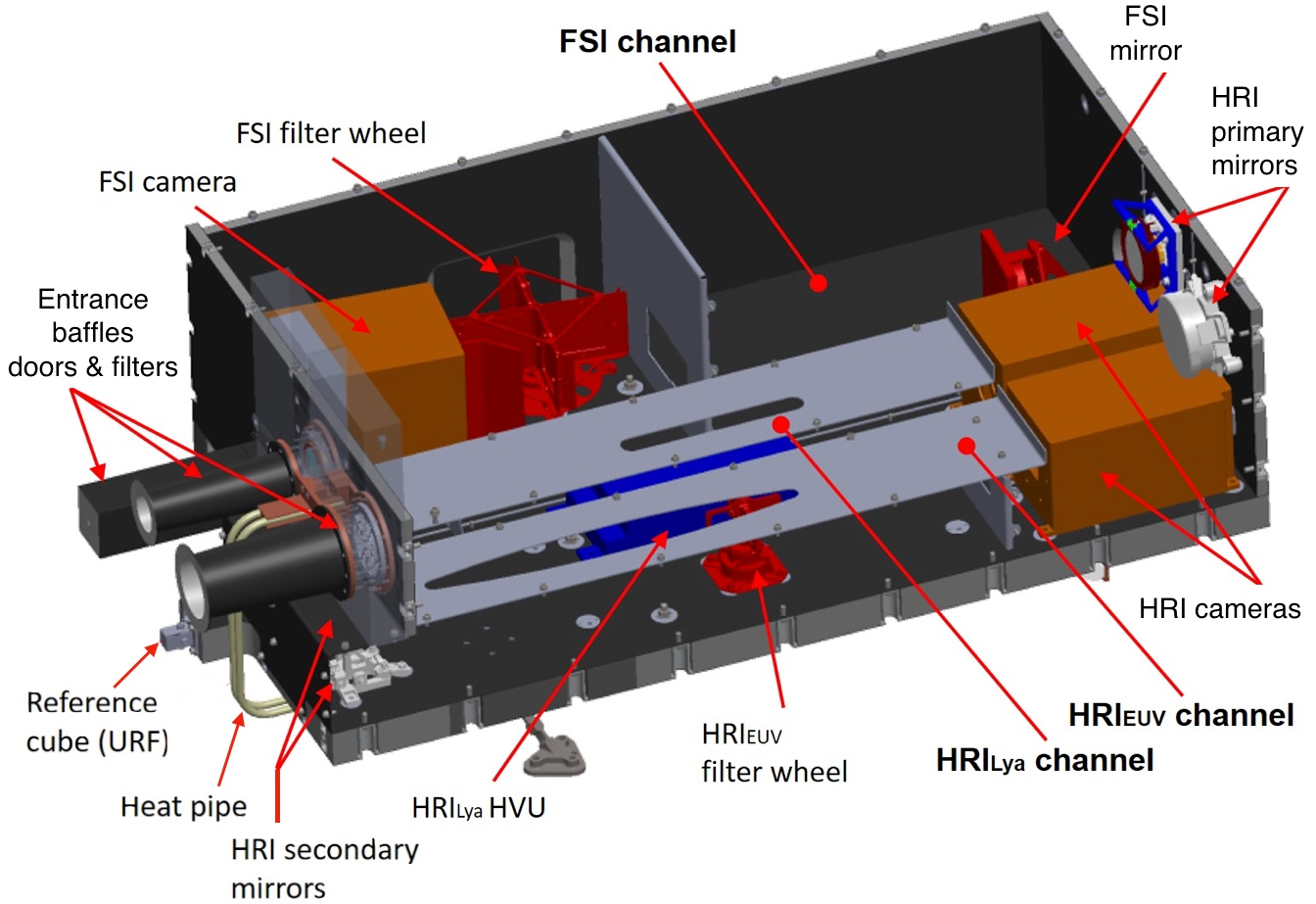The Extreme Ultraviolet Imager (EUI) has been developed as part of the remote sensing instrument package of the Solar Orbiter mission.
EUI consists of three telescopes that are optimized to image the solar atmosphere in Lyman-α (121.6 nm, temperature of roughly 30000 K) and EUV (17.4 nm and 30.4 nm, temperatures of roughly 1 MK and 0.08 MK respectively).
The three telescopes are:
- The Full Sun imager (FSI) and
- Two High Resolution Imagers (HRI)
The FSI is a one-mirror telescope, while the two HRI telescopes are two-mirror optical systems, all working in near normal incidence. Spectral selection is obtained with specific multi-layered coatings on the mirrors, complemented by filters that reject the visible and infrared radiation.
The two HRI apertures are protected by a common heat shield door. The FSI aperture is protected by a second, separate heat shield door. In addition, each telescope has its own instrument door protecting the optical entrance aperture. Operating an EUI telescope thus requires that both the corresponding heat shield door and instrument door are opened.

EUI detectors are directly derived from the concept of the CMOS-APS sensors, previously pioneered in orbit for solar physics by the PROBA2/SWAP telescope (Seaton et al., 2013; Halain et al., 2013).
FSI
- Type: a single off-axis mirror (Herschelian telescope)
- Field of view (FOV): 3.8° × 3.8°, corresponding to [14.3 × 14.3] solar radii (Rs) at 1 AU and [4 × 4] Rs at perihelion so that the whole Sun can be seen when the spacecraft is pointing at the solar limb.
- Angular resolution: 10 arcsec.
- Wavelength: two narrow passbands centered on 30.4 nm and 17.4 nm to image the transition region and the EUV corona. The 30.4 nm bandpass corresponds to a temperature of roughly 80000 K and the 17.4 nm bandpass corresponds to a temperature of roughly 1 million degrees.
- Typical exposure time: 10 seconds.
- Cadence: from 1 to 30 min (synoptics); can be up to 13 s
- Detector: CMOS-APS, 3072 × 3072 pixels.
HRI-EUV
- Type: two-mirror optical design (off-axis Cassegrain telescope)
- FOV: 1000” × 1000”, corresponding to [1 × 1] Rs at 1 AU and [0.29 × 0.29] Rs at perihelion
- Angular resolution: 1 arcsec
- Wavelength: a narrow passband centered on 17.4 nm to image the EUV corona. The bandpass corresponds to a temperature of roughly 1 million degrees
- Typical exposure times: a few seconds
- Cadence: from 3 s to 1 hour
- Detector: CMOS-APS, 3072 × 3072 pixels (typical pixel range 2048 × 2048 pixels).
HRI-Lyα
- Type: two-mirror optical design (off-axis Gregory telescope)
- FOV: 1000” x 1000”, corresponding to approx. [1 x 1] Rs at 1 AU and [0.29 x 0.29] Rs at perihelion
- Angular resolution: 1 arcsec
- Wavelength: a narrow passband centered on 121.6 nm to image the lower chromosphere/upper transition region. The bandpass corresponds to a temperature of roughly 30000 K
- Typical exposure times: a few seconds
- Cadence: from 3 s to 1 hour
- Detector: CMOS-APS, 3072 × 3072 pixels (typical pixel range 2048 × 2048 pixels).
EUI science output
- FSI will provide a view on the global morphology of the solar atmosphere (active regions, coronal holes, quiet Sun).
- FSI will help us understand the initial phase of solar eruptive processes such as flares, CMEs and dimmings (Green et al. 2018).
- The large FOV of FSI will bring new opportunities to study stealth CMEs that originate at high altitudes in the corona.
- HRI will image fine structures and small-scale events in the solar atmosphere.
More details can be found in the instrument paper: Rochus et al., 2020.